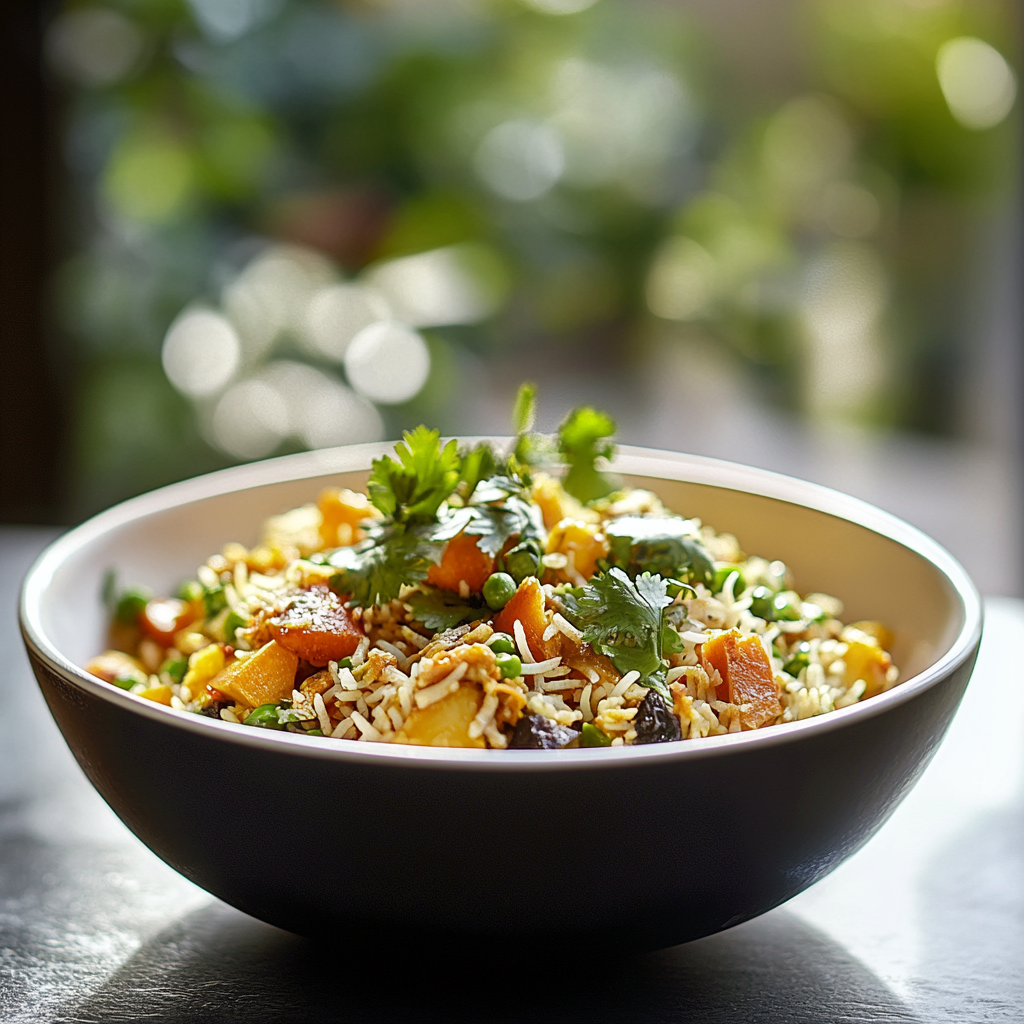Have you ever experienced the magic of a dish that fills your home with warmth and rich aromas? Vegetable Biryani is one such delightful meal that tantalizes your senses and brings comfort with every bite. This fragrant rice dish combines an array of colorful vegetables and aromatic spices, creating a symphony of flavors that is simply irresistible.

Growing up, my family would gather around the dining table on special occasions to share this vibrant dish. Each spoonful was a celebration—a mix of textures from tender veggies to fluffy rice—making it a cherished memory worth reliving. Whether it’s a festive gathering or a cozy weeknight dinner, this Vegetable Biryani promises to elevate any meal into something extraordinary. Get ready to embark on a culinary journey that will leave your taste buds dancing!
Why You’ll Love This Vegetable Biryani
- Flavor Explosion: The combination of spices like cumin, cardamom, and cloves creates layers of flavor that make each bite unforgettable.
- Health Benefits: Packed with fresh vegetables and whole grains, this dish offers a nutritious meal option without sacrificing taste.
- Versatile Meal: Perfect for lunch or dinner, this biryani pairs well with yogurt or salad for an enjoyable dining experience.
- Easy to Prepare: With straightforward steps and common ingredients, making Vegetable Biryani is simpler than you might think!

Ingredients for Vegetable Biryani
Here’s what you’ll need to make this delicious dish:
- Basmati Rice: Choose long-grain basmati rice for its fluffy texture; soak it in water for at least 30 minutes before cooking.
- Mixed Vegetables: Use carrots, peas, green beans, and bell peppers for a colorful mix; fresh or frozen are both good options.
- Onion: Sliced thinly; caramelizing the onion adds sweetness and depth to the flavor.
- Garlic and Ginger Paste: Freshly made paste enhances the aroma; use equal parts garlic and ginger for balance.
- Biryani Masala: Store-bought or homemade spice blend that gives authentic flavor; adjust quantity according to your spice preference.
For the Garnish:
- Cilantro: Chopped fresh cilantro adds brightness; sprinkle generously as a topping before serving.
The full ingredients list, including measurements, is provided in the recipe card directly below.
How to Make Vegetable Biryani
Follow these simple steps to prepare this delicious dish:
Step 1: Prepare the Rice
Rinse the basmati rice under cold water until the water runs clear. Soak it in water for about 30 minutes before draining.
Step 2: Sauté Onions
In a large pot over medium heat, add oil and sauté sliced onions until golden brown. This should take about 5-7 minutes.
Step 3: Add Garlic and Ginger
Stir in garlic and ginger paste into the pot. Cook for another minute until fragrant.
Step 4: Incorporate Vegetables
Add mixed vegetables along with salt and stir-fry everything together for about five minutes until they start to soften.
Step 5: Add Spices
Mix in biryani masala along with drained rice. Stir gently to combine all ingredients without breaking the rice grains.
Step 6: Cook Everything Together
Pour in water (usually double the amount of rice) into the pot. Bring it to a boil then reduce the heat to low. Cover tightly and cook for about twenty minutes until all water is absorbed.
Transfer to plates and garnish with chopped cilantro for the perfect finishing touch.

Tips and Tricks
Here are some helpful tips to ensure the best results for your dish:
- Soaking Rice: Always soak basmati rice before cooking; it helps achieve fluffy grains while cooking.
- Spice Level Adjustment: Feel free to adjust spices according to your preference; start small if you’re unsure!
- Resting Time: Letting the biryani sit covered after cooking allows flavors to meld beautifully; give it about ten minutes before serving.
Enjoy making your Vegetable Biryani as you explore its rich flavors!
Mistakes to avoid
- Overcooking the Rice: One common mistake when preparing Vegetable Biryani is overcooking the rice. When you cook the rice for too long, it can become mushy and lose its texture. Ideally, you should parboil the rice until it is about 70% cooked before layering it with vegetables and spices. This allows the rice to absorb flavors without turning soggy during the final cooking stage.
- Not Using Enough Spices: Vegetable Biryani relies heavily on spices for its rich flavor profile. Skipping or skimping on spices such as cumin, cardamom, or bay leaves can result in a bland dish. Make sure to use a balanced mix of whole and ground spices to enhance the dish’s complexity. Remember that the right amount of seasoning elevates your biryani from ordinary to extraordinary.
- Ignoring Quality Ingredients: The quality of ingredients plays a vital role in making a delicious Vegetable Biryani. Using stale or inferior-quality rice, vegetables, or spices can negatively impact your dish’s taste. Always opt for fresh, high-quality ingredients to ensure that each bite is flavorful and satisfying. Investing in good produce and spices will pay off in your final dish.
Serving Suggestions
This Vegetable Biryani is versatile and pairs wonderfully with:
- Raita: A refreshing yogurt-based side dish that complements the spices in the biryani beautifully. Cucumber or mint raita works best.
- Salad: A simple salad of sliced onions, tomatoes, and cucumbers adds a crisp texture and balances the warm flavors of the biryani.
- Papad: Crispy papads can add crunchiness to your meal. Serve them on the side for extra flavor and texture.

FAQs
What ingredients are essential for Vegetable Biryani?
To prepare a flavorful Vegetable Biryani, you will need basmati rice, assorted vegetables like carrots, peas, and potatoes, as well as spices such as cumin, coriander, and garam masala. Fresh herbs like cilantro and mint enhance the aroma, while onions and tomatoes form a savory base. Don’t forget ghee or oil for cooking. Each ingredient plays a vital role in creating the rich taste that makes this dish so beloved.
Can I make Vegetable Biryani ahead of time?
Yes, making Vegetable Biryani ahead of time is entirely feasible. In fact, allowing it to rest enhances its flavors. Cook the biryani and let it cool before storing it in an airtight container in the refrigerator. When ready to serve, gently reheat it on low heat, adding a splash of water to prevent dryness. This method ensures that your Vegetable Biryani remains delicious even after a day or two.
Is Vegetable Biryani suitable for vegans?
Absolutely! Vegetable Biryani is naturally vegan when prepared without ghee or dairy products. Instead of ghee, opt for vegetable oil or coconut oil to maintain its rich flavor while keeping it plant-based. This dish is perfect for those following a vegan lifestyle while still providing hearty nutrition through vegetables and spices.
What are some common variations of Vegetable Biryani?
There are numerous variations of Vegetable Biryani across different regions. Some popular versions include Hyderabadi Biryani with its unique layering technique and fragrant spices or Sindhi Biryani known for its tanginess from yogurt. You can also find variations that incorporate different vegetables or even substitute rice with quinoa for a healthier twist on this classic dish.
Conclusion for Vegetable Biryani
In conclusion, preparing a delightful Vegetable Biryani involves selecting fresh ingredients and balancing flavors with aromatic spices. Serving it with sides like raita or salad enhances your meal experience. Whether you choose to make it ahead or adapt it to suit your dietary preferences, this dish remains a crowd-pleaser at any gathering. By following this recipe and incorporating your favorite vegetables, you’ll create an irresistible meal that showcases both comfort and culinary creativity. Enjoy every bite of your homemade Vegetable Biryani!

Vegetable Biryani
Vegetable Biryani is a colorful and aromatic dish that brings together fluffy basmati rice and a vibrant mix of vegetables, all infused with a delightful blend of spices. This easy recipe captures the essence of Indian cuisine, making it perfect for festive gatherings or cozy weeknight dinners. Each bite offers an explosion of flavors, combining tender vegetables with fragrant rice for a satisfying meal that will please both vegetarians and meat-lovers alike. With straightforward steps and readily available ingredients, you can create this mouthwatering dish in no time. Prepare to impress your family and friends with this delectable Vegetable Biryani—your taste buds will thank you!
- Total Time: 45 minutes
- Yield: Serves 4
Ingredients
- 1 cup basmati rice
- 1 cup mixed vegetables (carrots, peas, green beans, bell peppers)
- 1 medium onion (thinly sliced)
- 1 tablespoon garlic and ginger paste
- 2 tablespoons biryani masala
- Fresh cilantro (for garnish)
- 2 tablespoons oil
- Salt to taste
- 2 cups water
Instructions
- Rinse basmati rice under cold water until clear; soak for 30 minutes and drain.
- In a large pot, heat oil over medium heat. Sauté onions until golden brown (5-7 minutes).
- Stir in garlic and ginger paste; cook for another minute until fragrant.
- Add mixed vegetables and salt; stir-fry for about 5 minutes until slightly softened.
- Mix in biryani masala and drained rice; gently combine without breaking the rice.
- Pour in water; bring to a boil, then cover and reduce heat to low. Cook for 20 minutes until water is absorbed.
- Garnish with chopped cilantro before serving.
- Prep Time: 15 minutes
- Cook Time: 30 minutes
- Category: Main
- Method: Cooking
- Cuisine: Indian
Nutrition
- Serving Size: 1 cup (200g)
- Calories: 320
- Sugar: 3g
- Sodium: 220mg
- Fat: 9g
- Saturated Fat: 1g
- Unsaturated Fat: 8g
- Trans Fat: 0g
- Carbohydrates: 54g
- Fiber: 4g
- Protein: 7g
- Cholesterol: 0mg






